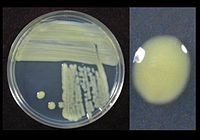
Photo from wikipedia
BackgroundBacteria of the genus Xanthomonas are economically important plant pathogens. Pathogenicity of Xanthomonas spp. depends on the type III-secretion system and additional virulence determinants. The number of sequenced Xanthomonas genomes… Click to show full abstract
BackgroundBacteria of the genus Xanthomonas are economically important plant pathogens. Pathogenicity of Xanthomonas spp. depends on the type III-secretion system and additional virulence determinants. The number of sequenced Xanthomonas genomes increases rapidly, however, accurate annotation of these genomes is difficult, because it relies on gene prediction programs. In this study, we used a mass-spectrometry (MS)-based approach to identify the proteome of Xanthomonas euvesicatoria (Xe) strain 85–10 also known as X. campestris pv. vesicatoria, a well-studied member of plant-pathogenic Xanthomonadaceae.ResultsUsing different culture conditions, MS-datasets were searched against a six-frame-translated genome database of Xe. In total, we identified 2588 proteins covering 55% of the Xe genome, including 764 hitherto hypothetical proteins. Our proteogenomic approach identified 30 new protein-coding genes and allowed correction of the N-termini of 50 protein-coding genes. For five novel and two N-terminally corrected genes the corresponding proteins were confirmed by immunoblot. Furthermore, our data indicate that two putative type VI-secretion systems encoded in Xe play no role in bacterial virulence which was experimentally confirmed.ConclusionsThe discovery and re-annotation of numerous genes in the genome of Xe shows that also a well-annotated genome can be improved. Additionally, our proteogenomic analyses validates “hypothetical” proteins and will improve annotation of Xanthomonadaceae genomes, providing a solid basis for further studies.
Journal Title: BMC Genomics
Year Published: 2017
Link to full text (if available)
Share on Social Media: Sign Up to like & get
recommendations!